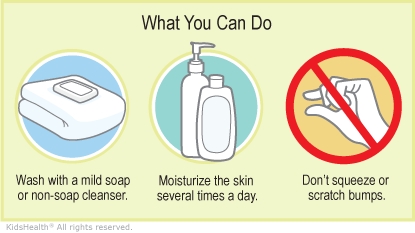Keratosis Pilaris: How to Care for Your Child
Keratosis pilaris is a common, harmless skin condition that causes groups of tiny bumps on the skin. Making some changes to your child's skin care may help the bumps become less noticeable.


-
Your child should use a mild soap or a non-soap cleanser when showering or taking a bath. Use warm — not hot — water.
-
Have your child apply a moisturizer to the skin after bathing and several other times a day.
-
Talk to your health care provider about which moisturizer is best for your child.
-
Use any prescription creams, ointments, or lotions as directed.
-
Use a humidifier if the air in your home is dry.
-
Remind your child not to squeeze or scratch the bumps.


What is keratosis pilaris? Keratosis pilaris happens when too much keratin (the hard protein that makes hair and nails) builds up inside hair follicles (the tiny skin openings that hair grows out of). When keratin builds up, little bumps form on the skin.
These bumps usually show up on the back of the upper arms and front of the thighs, though they can be on the cheeks, bottom, and other places. A child with keratosis pilaris may have redness around the bumps.
Keratosis pilaris isn't painful but sometimes the bumps can itch. It's not contagious. Symptoms tend to be worse in the winter or when skin gets dry.
What causes keratosis pilaris? Keratosis pilaris is thought to be a genetic disorder and can run in families. It often starts around puberty, then comes and goes through the teen years. Most kids grow out of it as adults.
How is keratosis pilaris diagnosed? To diagnose keratosis pilaris, the health care provider asks questions and does an examination. No other testing is needed.
What's the treatment for keratosis pilaris? Keratosis pilaris is not serious, and treatment usually is not needed. If the bumps bother a child, certain skin products may help. Gentle cleansers and moisturizers can help shed the skin's outer layers, making the bumps look better. If there is no improvement, the health care provider may recommend a prescription cream, ointment, or lotion.